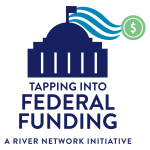Introducing River Network’s Equitable Infrastructure Toolkit
“Inequality impacts rivers, too, because that’s where it ends up ultimately.”
–Catherine Coleman Flowers, River Rally 2021
How are decisions to use green infrastructure versus a detention pond to control stormwater runoff made? What are the options for making water rates more affordable? How can states prioritize those most in need through their water infrastructure programs? What funding sources are available at the federal level to address critical water infrastructure needs?
If you’ve ever wondered about these questions and others relating to how funding decisions about drinking water, wastewater and stormwater are made, our new Equitable Infrastructure Toolkit was created for you. Broken into sections on utilities, affordability, infrastructure, and how to influence the decision-making process, it offers education and practical advice for advocates at to get involved at the local, state, and federal levels, whether you’re a seasoned advocate or just starting to get involved for your water.
With water rates rising in many places, close to 12% of U.S. households face unaffordable water bills. At the same time our creeks and rivers that supply drinking water for many of us are still threatened by contaminants and development. The 2021 Report Card on America’s Infrastructure grades our water infrastructure from a C- to a D, reflecting that our water systems need major investments and are vulnerable to the extreme events that are becoming more common due to climate change.
No doubt that there is a need for more funding to restore our water infrastructure and communities – and we’re advocating for that to happen – and for this investment to be made equitably, ensuring that communities who most need this funding are the ones that receive it. This means prioritizing investment in rural, low-income, and communities of color who have historically not had access to or received water infrastructure funding, resulting in unequal health, economic, and environmental impacts.
At River Network, we define “equitable water infrastructure investment” when infrastructure dollars for clean water, drinking water, and stormwater are:
- Directed by the community toward public health and clean, safe, affordable, and accessible water;
- Distributed in a way that supports low-income, rural, and communities of color most at-risk from environmental harms and historic lack of investment; and
- Supporting the long-term sustainability of our waterways and water systems and utilities.
What does this all mean practically? Made possible with support from Spring Point Partners and the Charles Stewart Mott Foundation, our Equitable Water Infrastructure Toolkit helps find the answers! This toolkit will build your understanding of these issues and learn how to influence water infrastructure funding and water affordability in your local community, at the state level, and nationally. By using this toolkit, you will be able to:
- Identify factors that affect water affordability and some approaches to addressing them;
- Become familiar with water infrastructure funding and financing mechanisms (e.g. state revolving loan funds and bonds) and how they can be better directed;
- Understand and influence decisions at the local, state, and federal levels.
To learn more, join our team on June 30 at 2:30 PM ET/11:30 AM PT for a workshop where we’ll walk you through making the most out of the toolkit – and look for additional training opportunities starting later this summer.






